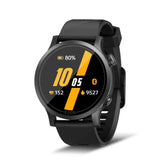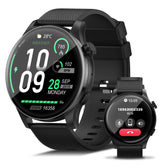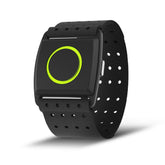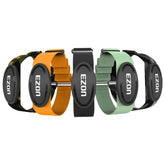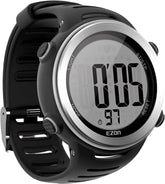Fitness Tracking Revolution: Wearable Tech for Workouts and Triathlon Preparation
The intersection of sports wearable technology and athletic performance has reached unprecedented heights, transforming how athletes train, recover, and compete. For triathletes—juggling swimming, cycling, and running—the right fitness tracker watch or triathlon watch isn’t just a gadget; it’s a lifeline. From real-time biometrics to race-day optimization, here’s how cutting-edge wearables are redefining endurance sports.
The Evolution of Sports Wearable Technology
Modern sports wearable technology has shifted from basic step counting to holistic health ecosystems. Advanced sensors now capture metrics like:
-
Muscle oxygen saturation (SmO₂) for endurance optimization
-
Lactate threshold estimation to delay fatigue
-
Swim-specific metrics (stroke efficiency, SWOLF scores)
-
Cycling dynamics (power output, pedal symmetry)
Devices like the Garmin Fenix 8 and Coros Apex 2 Pro integrate AI-driven insights, correlating training load, recovery, and environmental factors (heat, altitude) to personalize plans. This evolution mirrors findings from recent studies on wearable tech’s role in reducing injury risks and improving data-driven decision-making in sports science.
Key Features for Triathlon Preparation
A dedicated triathlon watch must excel across three disciplines while surviving extreme conditions. Prioritize these features:
1. Multi-Sport Mode & Transition Tracking
Seamlessly switch between swim, bike, and run modes with auto-detection. The Suunto 9 Peak offers Transition Time tracking, analyzing how gear changes impact overall race performance.
2. Open-Water Swim Readiness
Look for 5 ATM+ waterproofing and tidal current data. The Garmin Forerunner 955 Solar uses GPS and GLONASS to map open-water routes, while its Underwater Wrist-Based HR sensor maintains accuracy during swims.
3. Cycling Power Integration
Pair your watch with ANT+/Bluetooth power meters (e.g., Wahoo KICKR) to monitor wattage and cadence. The Polar Vantage V3 calculates Leg Recovery Test scores post-ride, guiding brick workout adjustments.
4. Run Dynamics & Injury Prevention
Metrics like ground contact time and vertical oscillation help refine running economy. The Coros Vertix 3 flags asymmetries that could lead to overuse injuries—a critical insight for high-mileage training blocks.
5. Battery Life & Solar Charging
A true triathlon watch needs 30+ hours in GPS mode. Solar variants like the Garmin Enduro 3 extend battery life by 40% during ultradistance events.
Top 2025 Wearables for Triathletes
Garmin Epix Pro (Gen 2)
This flagship model shines with AMOLED touchscreen clarity and Training Readiness Pro, which factors sleep, stress, and recovery into daily workout suggestions. Its Race Widget simulates courses like Kona, adjusting hydration alerts based on historical weather data.
Coros Apex 2 Pro
A budget powerhouse offering EvoLab’s triathlon-specific analytics. The Triathlon Score predicts race-day performance across disciplines, while 3D Distance Mapping optimizes elevation transitions.
Polar Vantage V4
Pioneers FuelWise 2.0, a real-time nutrition advisor that syncs with sweat loss data. Its Triathlon Pro Pack includes structured brick workouts and T1/T2 transition drills.
Suunto Race
Designed for extreme conditions, it combines MIL-STD-810H ruggedness with Heat Acclimation Insights—vital for training in hot climates. The Offline Maps feature ensures navigation sans smartphone.
Leveraging Data for Triathlon Success
1. Periodization & Load Management
Use your fitness tracker watch’s Training Load Ratio to balance intensity. For example, if your watch flags a 30% imbalance in swim vs. bike load, adjust volume to prevent overtraining.
2. Race-Specific Simulations
Replicate race conditions:
-
Swim: Enable OpenWater HR mode and practice sighting with route alerts.
-
Bike: Upload course GPX files to preview climbs (e.g., Alpe d’Huez gradients).
-
Run: Activate PacePro strategies for negative splits on hilly routes.
3. Recovery Optimization
Advanced sports wearable technology like the Whoop 5.0 quantifies strain from each discipline. Pair HRV (Heart Rate Variability) with Sleep Coach to prioritize rest before key workouts.
4. Nutrition & Hydration Alerts
Devices like the Garmin Enduro 3 sync with Smart Hydration sensors, calculating fluid loss via sweat rate and ambient temperature. Receive mid-race reminders to consume electrolytes or carbs.
Future Trends in Triathlon Tech
By 2026, expect:
-
Non-invasive glucose monitors for real-time fueling feedback.
-
AR-enabled swim goggles projecting navigation lines and split times.
-
AI race strategists that adjust pacing based on competitor data streams.
Choosing Your Triathlon Companion
When selecting a fitness tracker watch or triathlon watch, consider:
-
Ecosystem compatibility (Strava, TrainingPeaks)
-
Multi-band GPS accuracy for rural/urban transitions
-
Customizable data fields per sport (e.g., display power zones during cycling)
Final Thoughts
The sports wearable technology revolution has democratized elite-level insights, letting age-groupers train like pros. Whether you’re tackling a sprint triathlon or an Ironman, a robust triathlon watch becomes your coach, navigator, and health guardian. As sensors grow smarter and batteries more enduring, the line between human potential and technological empowerment will only blur further—propelling athletes toward once-unthinkable goals.
